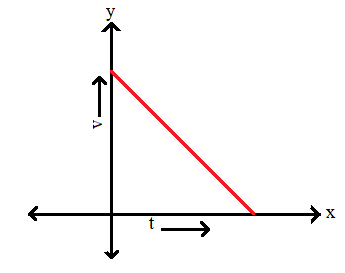
Velocity-time curve for a body projected vertically upwards is:
A. Parabola
B. Ellipse
C. Hyperbola
D. Straight line
Answer
510.1k+ views
Hint: when a body is projected upwards, its acceleration equals the gravitational acceleration. Since the body is moving in an upward direction, gravitational acceleration will be negative. By equating all these we get the velocity at an instant time,’t’. Compare the obtained equation with the equation of parabola, hyperbola, ellipse and straight line.
Formula used:
Acceleration,
$a=\dfrac{dv}{dt}$
Equation of straight line,
$y=mx+c$
Complete answer:
We have a body which is projected upwards with a velocity ‘v m/s’ in time “t seconds”.
We have to determine the shape of the velocity-time curve so obtained.

Consider a body which is projected upwards as shown in the above figure.
Its initial velocity, v=u. Since the body is projected in ‘y’ direction, we can say that $v={{u}_{y}}$.
We know that, when a body is moving upwards the acceleration due to gravity acts downwards.
This acceleration due to gravity will be equal to the acceleration of the body.
‘a = g’, were ‘a’ is the acceleration of the body and ‘g’ is gravitational acceleration.
We know, acceleration is the first derivative of velocity, with respect to time.
$a=\dfrac{dv}{dt}=g$
$\begin{align}
& \dfrac{dv}{dt}=g \\
& dv=g\times dt \\
\end{align}$
Now, let us integrate both sides of the equation.
$\int\limits_{u}^{v}{dv=\int\limits_{0}^{t}{gdt}}$ , ‘g’ is a constant.
By integrating, we get,
$\begin{align}
& v-u=gt \\
& v=u+gt \\
\end{align}$
We know gravitational acceleration ‘g’, is acting downwards.
Hence ‘g’ is negative.
Therefore we can write the equation $v=u+gt$ as,
$v=u-gt$
Now let us consider the equation of the straight line.
Straight line equation is given as,
$y=mx+c$, where ‘m’ is the slope and ‘c’ is the intercept of y axis.
Now let us compare the straight line equation with the equation we got, i.e. $v=u-gt$ .
From this we can understand that the velocity-time curve of the body projected upwards is a straight line with slope ‘-g’ and y intercept ‘u’.

Therefore it is a straight line.
So, the correct answer is “Option D”.
Note:
Velocity of a body is described as the distance or displacement of the body in a particular direction per unit interval of time.
Rate of change in position of a body with respect to time is the average velocity of that body.
Equation of parabola is $y=a{{x}^{2}}+bx+c$
Equation of ellipse is $\dfrac{{{x}^{2}}}{{{a}^{2}}}+\dfrac{{{y}^{2}}}{{{b}^{2}}}=1$
Equation of hyperbola is $\dfrac{{{x}^{2}}}{{{a}^{2}}}-\dfrac{{{y}^{2}}}{{{b}^{2}}}=1$
Formula used:
Acceleration,
$a=\dfrac{dv}{dt}$
Equation of straight line,
$y=mx+c$
Complete answer:
We have a body which is projected upwards with a velocity ‘v m/s’ in time “t seconds”.
We have to determine the shape of the velocity-time curve so obtained.

Consider a body which is projected upwards as shown in the above figure.
Its initial velocity, v=u. Since the body is projected in ‘y’ direction, we can say that $v={{u}_{y}}$.
We know that, when a body is moving upwards the acceleration due to gravity acts downwards.
This acceleration due to gravity will be equal to the acceleration of the body.
‘a = g’, were ‘a’ is the acceleration of the body and ‘g’ is gravitational acceleration.
We know, acceleration is the first derivative of velocity, with respect to time.
$a=\dfrac{dv}{dt}=g$
$\begin{align}
& \dfrac{dv}{dt}=g \\
& dv=g\times dt \\
\end{align}$
Now, let us integrate both sides of the equation.
$\int\limits_{u}^{v}{dv=\int\limits_{0}^{t}{gdt}}$ , ‘g’ is a constant.
By integrating, we get,
$\begin{align}
& v-u=gt \\
& v=u+gt \\
\end{align}$
We know gravitational acceleration ‘g’, is acting downwards.
Hence ‘g’ is negative.
Therefore we can write the equation $v=u+gt$ as,
$v=u-gt$
Now let us consider the equation of the straight line.
Straight line equation is given as,
$y=mx+c$, where ‘m’ is the slope and ‘c’ is the intercept of y axis.
Now let us compare the straight line equation with the equation we got, i.e. $v=u-gt$ .
From this we can understand that the velocity-time curve of the body projected upwards is a straight line with slope ‘-g’ and y intercept ‘u’.

Therefore it is a straight line.
So, the correct answer is “Option D”.
Note:
Velocity of a body is described as the distance or displacement of the body in a particular direction per unit interval of time.
Rate of change in position of a body with respect to time is the average velocity of that body.
Equation of parabola is $y=a{{x}^{2}}+bx+c$
Equation of ellipse is $\dfrac{{{x}^{2}}}{{{a}^{2}}}+\dfrac{{{y}^{2}}}{{{b}^{2}}}=1$
Equation of hyperbola is $\dfrac{{{x}^{2}}}{{{a}^{2}}}-\dfrac{{{y}^{2}}}{{{b}^{2}}}=1$
Recently Updated Pages
Why are manures considered better than fertilizers class 11 biology CBSE

Find the coordinates of the midpoint of the line segment class 11 maths CBSE

Distinguish between static friction limiting friction class 11 physics CBSE

The Chairman of the constituent Assembly was A Jawaharlal class 11 social science CBSE

The first National Commission on Labour NCL submitted class 11 social science CBSE

Number of all subshell of n + l 7 is A 4 B 5 C 6 D class 11 chemistry CBSE

Trending doubts
What is meant by exothermic and endothermic reactions class 11 chemistry CBSE

10 examples of friction in our daily life

One Metric ton is equal to kg A 10000 B 1000 C 100 class 11 physics CBSE

1 Quintal is equal to a 110 kg b 10 kg c 100kg d 1000 class 11 physics CBSE

Difference Between Prokaryotic Cells and Eukaryotic Cells

What are Quantum numbers Explain the quantum number class 11 chemistry CBSE




